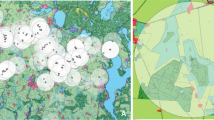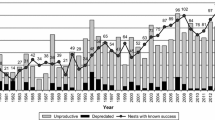Abstract
Our objectives were to determine if concentrations of environmental pollutants and microbial contamination in nonviable eggs of the endangered Mississippi sandhill crane (Grus canadensis pulla) contributed to egg failure. Six eggs collected in 1990 and four in 1991 contained only background levels of organochlorine pesticides and polychlorinated biphenyls (PCBs), and tests for microbial contamination were all negative. Two eggs contained late dead embryos, but neither revealed obvious abnormalities. Three eggs contained potentially harmful concentrations (23, 39, 146 pg/g, wet mass) of polychlorinated dibenzo-p-dioxins (PCDDs) and dibenzofurans (PCDFs), based on 2,3,7,8-tetrachlorodibenzo-p-dioxin equivalents (TCDD-EQ) for combined compounds. Because of the scarcity of material suitable for laboratory examination and the endangered status of the crane, we recommend that nonviable eggs continue to be monitored for toxic pollutants.
Similar content being viewed by others
References
Ballschmiter, K., and Zell, M.: 1980, ‘Analysis of Polychlorinated Biphenyls (PCBs) by Gas Capillary Gas Chromatography, Composition of Technical Aroclor- and Clophen-PCB Mixtures’,Frezenius' Z. Anal. Chem. 302, 20–31.
Blus, L. J., Henny, C. J., and Grove, R. A.: 1989, ‘Rise and Fall of Endrin Usage in Washington State Fruit Orchards: Effects on Wildlife’,Environ. Poll. 60, 331–349.
Edgerton, S. A., Czuczwa, J. M., and Rench, J. D.: 1989, ‘Ambient Air Concentrations of Polychlorinated Dibenzo-p-dioxins and Dibenzofurans in Ohio: Sources and Health Risk Assessment’,Chemosphere 18, 1713–1730.
Eisler, R.: 1986, ‘Dioxin Hazards to Fish, Wildlife, and Invertebrates: a Synoptic Review’,U.S. Fish and Wild. Serv. Biol. Rep. 85 (1.8), 37 pp.
Elliot, J. E., Butler, R. W., Norstrom, R. J., and Whitehead, P. E.: 1988, ‘Levels of Polychlorinated Dibenzodioxins and Polychlorinated Dibenzofurans in Eggs of Great Blue Herons (Ardea herodias) in British Columbia, 1983–87: Possible Impacts on Reproductive Success’,Can. Wildl. Serv., Prog. Note 176.
Erickson, R. C.: 1975, ‘Captive Breeding of Whooping Cranes at the Patuxent Wildlife Research Center’, in: Martin, R. D., (Ed.),Breeding Endangered Species in Captivity, Academic Press, New York, pp. 99–114.
Erickson, R. C.: 1976, ‘Captive Breeding of Whooping Cranes at the Patuxent Wildlife Research Center’,Proc. International Crane Workshop, Oklahoma State Univ. Print. Publ., Stillwater, pp. 166–176.
Gilbertson, M.: 1983, ‘Etiology of Chick Edema Disease in Herring Gulls in the Lower Great Lakes’,Chemosphere 12, 357–370.
Henny, C. J., Blus, L. J., Krynitsky, A. J., and Bunck, C. M.: 1984, ‘Current Impact of DDE on Black-crowned Night-Herons in the Intermountain West’,J. Wildl. Manage. 48, 1–13.
Hong, Chia-Swee, and Bush, B.: 1990, ‘Determination of Mono-and Non-Ortho Coplanar PCBs in Fish’,Chemosphere 2, 173–181.
Hyde, K. M., Graves, J. B., Watts, A. B., and Bonner, F. L.: 1973, ‘Reproductive Success of Mallard Ducks Fed Mirex’,J. Wildl. Manage. 37, 479–484.
Kubiak, T. J., Harris, H. J., Smith, L. M., Schwartz, T. R., Stalling, D. L., Trick, J. A., Sileo, L., Docherty, D. E., and Erdman, T. C.: 1989, ‘Microcontaminants and Reproductive Impairment of the Forster's Tern on Green Bay, Lake Michigan-1983’,Arch. Environ. Contam. Toxicol. 18, 706–727.
Longcore, J. R., and Stendell, R. C.: 1977, ‘Shell Thinning and Reproductive Impairment in Black Ducks After Cessation of DDE Dosage’,Arch. Environ. Contam. Toxicol. 6, 293–304.
Safe, S.: 1990, ‘Polychlorinated Biphenyls (PCBs), Dibenzo-p-dioxins (PCDDs), Dibenzofurans (PCDFs), and Related Compounds: Environmental and Mechanistic Considerations Which Support the Development of Toxicity Equivalency Factors (TEFs)’,Crit. Rev. Toxicol. 21, 51–88.
Smith, L. M., Stalling, D. L., and Johnson, J. L.: 1984, ‘Determination of Parts-Per-Trillion Levels of Polychlorinated Dibenzofurans and Dioxins in Environmental Samples’,Anal. Chem. 56, 1830–1842.
Stickel, L. F., Stickel, W. H., McArthur, R. D., and Hughes, D. L.: 1979, ‘Chlordane in Birds: A Study of Lethal Residues and Loss Rates’, in: Deichmann, W. B., (Ed.),Toxicology and Occupational Medicine, Elsevier/North-Holland, New York, pp. 387–396.
Tiernan, T. O., Wagel, D. J., Vanness, G. F., Garrett, J. H., Solch, J. G., and Harden, L. A.: 1989, ‘PCDD/PCDF in the Ambient Air of a Metropolitan Area in the U.S.’,Chemosphere 19, 541–546.
U. S. Environmental Protection Agency: 1985,Suspended, Cancelled, and Restricted Pesticides, 3rd revision, Office of Public Awareness, Washington, D. C., 29 pp.
U. S. Environmental Protection Agency: 1989, ‘Interim Procedures for Estimating Risks Associated with Exposure to Mixtures of Chlorinated Dibenzo-p-dioxins and Dibenzofurans (CDDs and CDFs)’,Risk Assess. Forum, EPA/625/3-89/016, Washington, D. C., 69 pp.
White, D. H., Fleming, W. J., and Ensor, K. L.: 1988, ‘Pesticide Contamination and Hatching Success of Waterbirds in Mississippi’,J. Wildl. Manage. 52, 724–729.
White, D. H., and Seginak, J. T.: 1994, ‘Dioxins and Furans Linked to Reproductive Impairment in Wood Ducks’,J. Wildl. Manage. 58, 100–106.
Author information
Authors and Affiliations
Rights and permissions
About this article
Cite this article
White, D.H., Rice, C.P., Hoffman, D.J. et al. Environmental contaminants in nonviable eggs of the endangered Mississippi sandhill crane (Grus canadensis pulla). Environ Monit Assess 31, 225–232 (1994). https://doi.org/10.1007/BF00577255
Received:
Issue Date:
DOI: https://doi.org/10.1007/BF00577255




